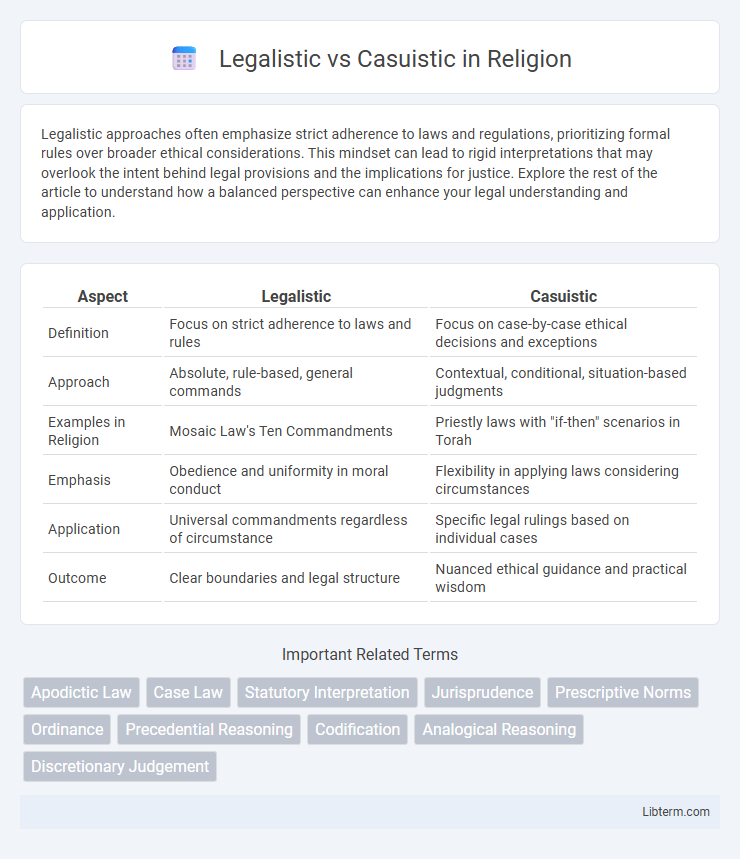Legalistic approaches often emphasize strict adherence to laws and regulations, prioritizing formal rules over broader ethical considerations. This mindset can lead to rigid interpretations that may overlook the intent behind legal provisions and the implications for justice. Explore the rest of the article to understand how a balanced perspective can enhance your legal understanding and application.
Table of Comparison
| Aspect | Legalistic | Casuistic |
|---|---|---|
| Definition | Focus on strict adherence to laws and rules | Focus on case-by-case ethical decisions and exceptions |
| Approach | Absolute, rule-based, general commands | Contextual, conditional, situation-based judgments |
| Examples in Religion | Mosaic Law's Ten Commandments | Priestly laws with "if-then" scenarios in Torah |
| Emphasis | Obedience and uniformity in moral conduct | Flexibility in applying laws considering circumstances |
| Application | Universal commandments regardless of circumstance | Specific legal rulings based on individual cases |
| Outcome | Clear boundaries and legal structure | Nuanced ethical guidance and practical wisdom |
Understanding Legalistic and Casuistic Approaches
Legalistic approaches emphasize strict adherence to established laws and rules, prioritizing clear, objective criteria in decision-making processes. Casuistic approaches focus on analyzing individual cases' specific circumstances, applying moral reasoning and precedents to adapt legal principles contextually. Understanding these approaches highlights the contrast between rigid rule-following and flexible, case-by-case interpretation in legal and ethical frameworks.
Historical Origins of Legalism and Casuistry
Legalism originated in ancient China during the Warring States period, emphasizing strict laws and harsh punishments to maintain social order and state power. Casuistry emerged in medieval Europe as a method of ethical reasoning that resolved moral dilemmas by applying general principles to specific cases, heavily influenced by Scholasticism and Christian theology. Both frameworks reflect distinct historical legal philosophies, with Legalism rooted in centralized authority and Casuistry in moral flexibility and case-based analysis.
Key Definitions: Legalistic vs Casuistic
Legalistic frameworks emphasize strict adherence to explicit laws and rules, prioritizing uniform application and clear-cut regulations. Casuistic reasoning centers on case-based analysis, focusing on specific circumstances and contextual nuances to guide ethical or legal decision-making. This distinction highlights Legalistic approaches as rule-bound and systematic, whereas Casuistic approaches are flexible and situation-sensitive.
Main Principles of Legalistic Reasoning
Legalistic reasoning emphasizes strict adherence to formal rules and established laws, interpreting legal texts with precise, literal meaning to ensure consistency and predictability. It relies on universal principles and codified regulations, applying them uniformly across cases without considering individual circumstances or contextual nuances. This approach values clear boundaries and objective standards to maintain legal certainty and authority.
Core Features of Casuistic Analysis
Casuistic analysis emphasizes case-based reasoning, focusing on specific instances and their unique circumstances rather than abstract rules. It involves comparing current cases to precedent cases to determine ethical or legal outcomes, highlighting context sensitivity and practical judgment. This method prioritizes flexibility and nuance over rigid application, making it highly adaptable to complex, real-world scenarios.
Pros and Cons of Legalistic Methods
Legalistic methods emphasize strict adherence to predefined legal rules and principles, ensuring consistency and predictability in judicial decisions. However, this rigidity can lead to inflexibility, often disregarding unique case circumstances and moral considerations. While legalistic approaches promote clarity and uniformity, they may result in unjust outcomes when applied without contextual sensitivity.
Advantages and Limitations of Casuistry
Casuistry offers the advantage of practical flexibility by addressing moral dilemmas through specific case analysis rather than rigid rule application, allowing for nuanced ethical judgments in complex situations. This approach facilitates adaptation to diverse contexts and promotes empathy by considering individual circumstances, which enhances moral sensitivity. However, casuistry may face limitations such as potential inconsistency in ethical decisions and the risk of subjective bias, reducing the predictability and universality valued in more formalized legalistic frameworks.
Legalistic vs Casuistic in Modern Law
Legalistic approaches in modern law emphasize strict adherence to codified statutes and formal rules, prioritizing clear, authoritative legal texts for decision-making. Casuistic methods focus on case-by-case analysis, drawing on precedents and specific circumstances to resolve disputes flexibly and contextually. The interplay between legalistic rigidity and casuistic adaptability shapes contemporary judicial interpretation and legislative application worldwide.
Real-World Examples: Legalistic and Casuistic Cases
Legalistic cases emphasize strict adherence to established laws and regulations, exemplified by traffic violations where penalties are applied based on clear rules regardless of circumstances. Casuistic cases involve ethical decision-making tailored to specific situations, such as medical triage during emergencies where prioritizing treatment depends on patient conditions and outcomes. The distinction is evident in judicial systems, as legalistic courts enforce statutes literally, while casuistic approaches allow judges discretion to consider context and moral nuances.
Choosing Between Legalism and Casuistry
Choosing between legalism and casuistry involves balancing strict rule adherence with case-by-case moral reasoning. Legalism emphasizes universal laws and clear-cut guidelines, ensuring consistency and predictability in ethical decisions. Casuistry prioritizes contextual analysis, applying principles flexibly to complex situations where rigid rules may fall short.
Legalistic Infographic

 libterm.com
libterm.com